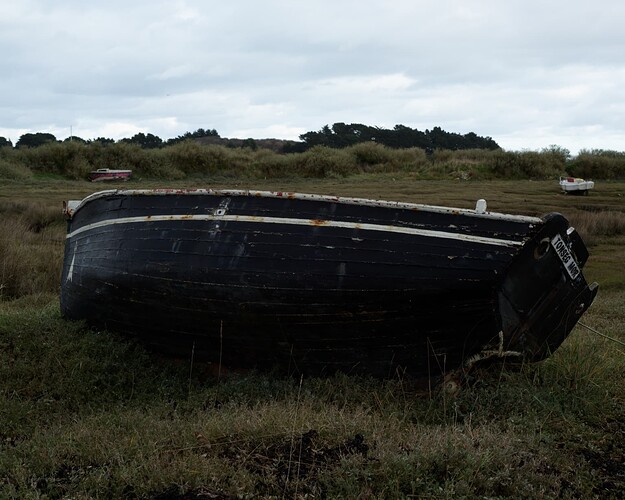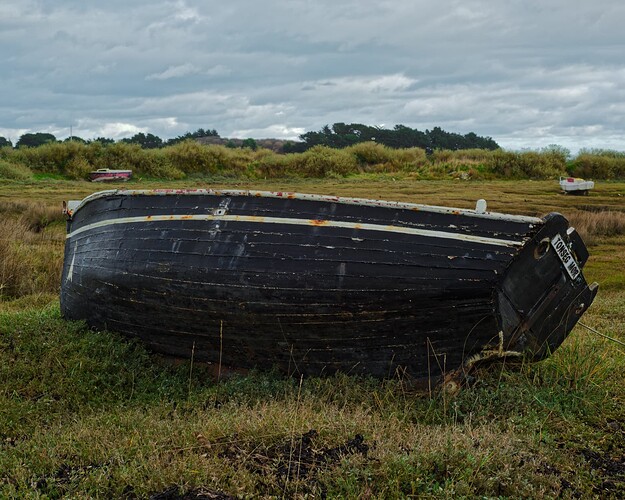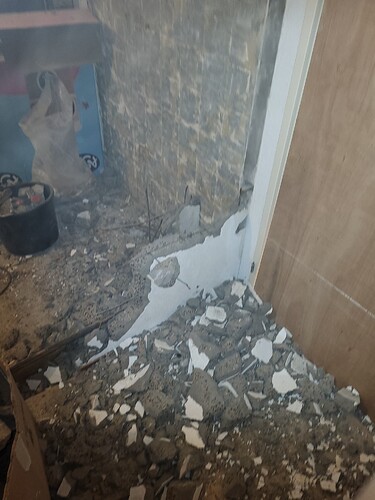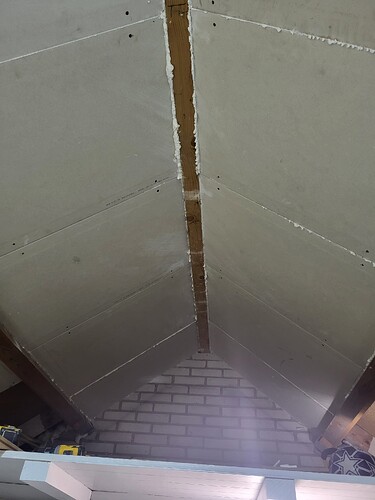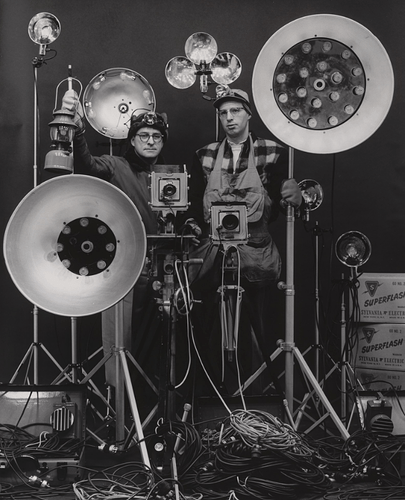I was going in and out during these two hours of boat ride trying to catch when the sun broke through but most of the time it was really boring because there was absolutely nothing to see, just an indescribable whiteness.
It is not light painting as known today. It was made with a big flood, with a wide coverage.
Yep, that´s right! I have an old friend that have been a professional since 50 years and he said “måla” in Swedish when I asked him about this and that word means precisely “paint”.
I’ve seen many photos of steam trains at night, either a large number of flashes, or just “painting with light”.
Google will bring up a lot of images similar to this, even some of trains in motion.
But the sensor was screaming at you to stop burning it out!!! With high dynamic range, you must measure for the highlights.
Take this image, measured for +1EV on the sky…
Rubbish! You might say but, because I metered for the sky and not the boat, after processing in PL to recover the shadow detail, I end up with detail in both the sky, the boat and the foreground…
Had I used centre weighted, I would have ended up with a totally over-exposed white sky.
No it wasn’t. The sky was blue and it was only the limitations of your vision that made you think it was pure white.
If you used your camera in the way it was intended to be used, and took control of it, instead of allowing it to control you, you would have gotten a better image.
Nope i would like a helicopter and a helicopterpilot.
If that isn’t available well ok i settle for a boat.
It’s part 2 but somehow i see the same images passing by.
Cruiseship, appartement building… ![]()
Yes i am lurking in the spare time i have.
Ive done nothing this year in dxoPL except some updating.
I have bin a carpenter, plasterer, electricien, tiler, roof repair aka dakhaas and now i am isolated drywall placer and kitchen renovater at the same time.
I take snapshots for reviewing later and those i wil edit a bit in dxopl after some time.
This was easy, removing those tiles on the otherhand…
Isolating the garage which is too small for my car but a great tools and mancave.
Redid the electra in the garage so we have motiondetection auto light for walking in and out .
This week emptying(removing the old kitchen) the kitchen area and update electra and plaster the walls and ceiling which i outsource. I can get a wall nice looking but straightlines so your countertop is smooth and equal against the wall is an other skill level.
Around the 15e new kitchen is placed which means i can finishing the details and then have a break. Taxes needs to be filled in and sent.
Hopefully also some time to play around in dxopl.
First getting this filled with cabinets. Then i get some nice food again😁

Joanna, one thing I have had to understand with all my Sony cameras is that they all over exposes in daylight. No real problem in other condition but in daylight I always have to reduce with 0,7 to 1 Ev. I have never seen the same behavior with my phones. Why can Samsung handle that in a beter way than Sony?
I’m guilty of this. The technology often seems like more than my brain can handle. Long ago I was better at this. Learn as you go works, but takes time to get proficient at it, but old age starts erasing things behind my back. Long ago, I felt more comfortable with the “technology”. Even the exposure technique @Joanna just described - a year or two ago I got it to work, but it took me several minutes just now to remember “how” it worked. I do best when I try to remember “HOW” it worked, after which it makes sense to me again.
DxO Photolab is full of things I used to remember, but I would need to re-learn to use them today.
Time for me to take a break, and come back to this series of discussions tonight or tomorrow. Too much happening, faster than I can deal with. But lots of good information to assimilate.
How do get the exposure from the histogram before you have taken the picture?
Bearing in mind that the histogram on the back screen is only for a jpeg and not for a RAW
My guess is that Samsung use a lot of computing and AI type stuff under the hood ![]()
@OXiDant
That was the reason why I moved to a completely renowated flat this time at the age of 72 two summers ago. I have “done” my construction work for this life time. ![]()
Don´t forget to take a break from time to time and have some fun too!
By taking a test shot and adjust settings.
Yes, the histogram is based on the jpg. So what. That’s what I want. As a photographer I’m output oriented. I see the clipping on my monitor, or print, not on my sensor.
Beside that, the mirrorless camera’s have often a realtime histogram.
But your method, spotmeter for the lightest subject and adjust +2EV(or less) gives the same result as with using the histogram.
George
I don’t have time for that. I know the exposure is going to be right without the histogram.
So am I and my output is large prints, which require every drop of precision, range and detail I can squeeze out the RAW file, which is considerably more than contained in a jpeg.
If we have the same exposure then we have the same RAW file.
George
I suspect that @Joanna’s point is that the spot meter is more precise, and the histogram can’t be that precise, so with the spot meter reading you get closer to the appropriate value.
I remember when I tested this, and it worked just as she said. I assume the “brightest spot” has to be something normal within the image, and not “the sun”. I was wondering if a neutral density filter would make this technique easier for excessively bright areas (such as the sun). I doubt it.
At some point, Nikon and the others will included this by default. The D780 in “live view” measures the sensor, just as mirrorless cameras do. Maybe eventually there will be a correction for this built right into “mirrorless” situations?
In fact the histogram doesn’t show exposure, simply the distribution of light levels within the whole area, based on an 8-bit scale. It cannot show the distribution of a 14-bit scale.
Indeed.
Not really. But graduated filters of the right density, at the right angle are only useful as long as nothing intrudes over the graduation line.
If they do, I’ll be sticking with my faithful D850
That’s total irrelevant. Replace the numbers by percentages and it’s bit depth independent. The histogram doesn’t change. Well, unless you want to use a bit depth of 2,3 or 4. But you won’t see a difference between 8 and 14.
Don’t confuse it with the bit depth of the working space. There a higher bit depth is important for editing.
George
The way Nikon did it, was to leave the camera in DSLR mode all the time except when you select “Live View”. At that moment the camera works just like Nikon’s “mirrorless” cameras.
Nikon D780 - DSLR or Mirrorless?
Not sure how useful this review is - it’s one person’s opinion, but it matches the D780 videos I’ve been watching on YouTube. I used to think I should get a D850 instead, but I decided not to make any changes, at least not for a very long time.
I rarely shoot in “Live View”. I will certainly use Live View for video, in this case, 4K. I prefer using a “real” viewfinder, which is one of the reasons why I don’t want a “mirrorless” camera, but apparently the D780 can do all that new stuff, just like a. dedicated mirrorless camera. At least all the stuff I might eventually care about.
That it is small, and light, and fits ME perfectly is a bonus. My Df is not really comfortable, and my body doesn’t remember what to do with my M10. I love my Fuji X100F, but I love the D780 a lot more.
AI? For now at least, I agree with @Joanna.
My good, old-fashioned film camera didn’t know about “focus tracking”, especially focus tracking of a person’s eye.
To me, these can be useful tools, and my new D780 has been configured to do them. But yes, I need to learn how to do so. Many things are “confusing” until one learns how to do so.
Like your technique to deal. with “highlights”.
How to not be confused by a camera - don’t watch the videos or read the manuals for how to do specialized things.
I’ve watched half a dozen videos of what my D780 is capable of - I can post a link to a simple one here if anyone cares.
Heck, my D780 has a world full of features that become available once I select “Live View”. I didn’t buy a mirrorless camera, where all those features are common - and a lot more. The D780 does almost all of them.
Hmm… “setting it up once and then using it like a good old fashioned film camera”.
This is essentially what I’ve already done. Finished.
But, I keep learning of new things the “mirrorless” mode allows, but not the “DSLR” mode.
Once the camera starts to analyze what is being recorded on the sensor, and allows me to control that, it’s a whole new world. I’m not sure I want to get involved in that yet, but I’m aware that it is already included in the camera.
If you were to spend the $10,000 or whatever, for a new Nikon Z9, you might find some of these things useful too. Maybe. But for the type of photography you do (or I do), maybe none of it is useful yet, let alone necessary. I guess I’ve had my head stuck in the sand, ignoring all those new how-to videos. For a few days now, I’ve been watching them.
(I struggle to keep people’s eyes sharp, and usually I do OK, but the D780 can do that for me better and faster than I could ever do.). But, enough of this. Let’s get back to using a DSLR, 850, 780, or whatever.)

